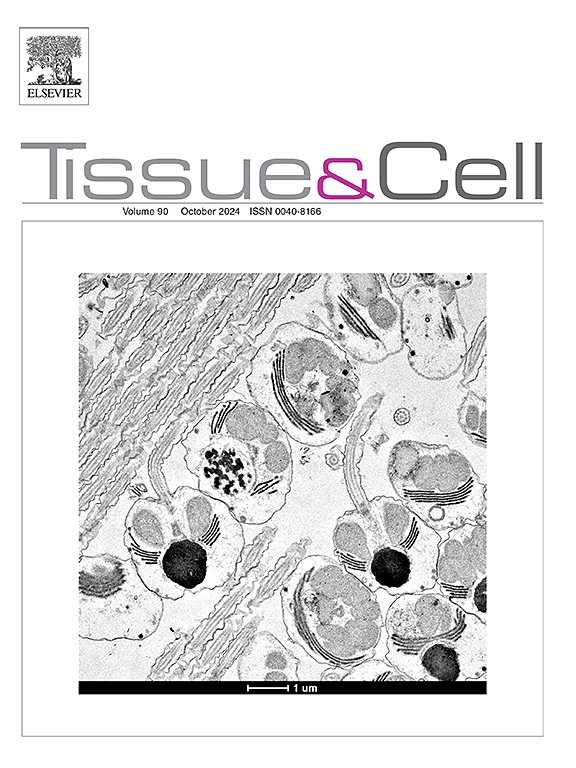Promotion of skin regeneration in diabetic rats by collagen-based hydrogel incorporated with basic fibroblast growth factor: A histological, molecular, and tensiometrical study
IF 2.5
4区 生物学
Q1 ANATOMY & MORPHOLOGY
引用次数: 0
Abstract
Diabetic wounds represent a major and costly challenge for diabetic patients, leading to significant morbidity and healthcare expenses. Consequently, extensive research has been dedicated to identifying effective treatments to enhance wound healing. Among these, biological hydrogels have emerged as promising candidates due to their superior properties over traditional materials. This study aimed to assess the efficacy of a bioactive and biodegradable collagen-based hydrogel derived from human amniotic membrane (CHA) combined with basic fibroblast growth factor (bFGF) in promoting wound healing in diabetic rats. A total of thirty diabetic rats were randomly divided into three groups (n = 10): control, CHA, and CHA incorporated with bFGF (CHA+bFGF). Wound evaluations were conducted on days 7 and 21. The findings revealed notable improvements in wound closure, fibroblast and blood vessel counts, collagen density, tensiometrical parameters, and the levels of VEGF in the treatment groups compared to the control group, with the most significant effects observed in the CHA+bFGF group. Moreover, the CHA+bFGF group demonstrated a greater reduction in inflammatory cells infiltration, along with lower concentration of TNF-α and IL-1β cytokines, compared to the other groups. In conclusion, the combination of CHA with bFGF proved to be highly effective in enhancing the healing process of diabetic wounds.
结合碱性成纤维细胞生长因子的胶原基水凝胶促进糖尿病大鼠皮肤再生:组织学、分子和张力学研究
糖尿病伤口对糖尿病患者来说是一个重大且昂贵的挑战,导致显著的发病率和医疗费用。因此,广泛的研究一直致力于确定有效的治疗方法,以提高伤口愈合。其中,生物水凝胶由于其优于传统材料的性能而成为有希望的候选者。本研究旨在评估一种生物活性和可生物降解的人羊膜胶原基水凝胶(CHA)联合碱性成纤维细胞生长因子(bFGF)促进糖尿病大鼠伤口愈合的效果。将30只糖尿病大鼠随机分为3组(n = 10):对照组、CHA组和CHA合并bFGF组(CHA+bFGF)。分别于第7天和第21天进行伤口评估。结果显示,与对照组相比,治疗组在伤口愈合、成纤维细胞和血管计数、胶原密度、张力参数和VEGF水平上均有显著改善,其中CHA+bFGF组效果最显著。此外,与其他组相比,CHA+bFGF组炎症细胞浸润的减少更大,TNF-α和IL-1β细胞因子的浓度也更低。综上所述,CHA联合bFGF对促进糖尿病创面愈合具有较好的疗效。
本文章由计算机程序翻译,如有差异,请以英文原文为准。
求助全文
约1分钟内获得全文
求助全文
来源期刊

Tissue & cell
医学-解剖学与形态学
CiteScore
3.90
自引率
0.00%
发文量
234
期刊介绍:
Tissue and Cell is devoted to original research on the organization of cells, subcellular and extracellular components at all levels, including the grouping and interrelations of cells in tissues and organs. The journal encourages submission of ultrastructural studies that provide novel insights into structure, function and physiology of cells and tissues, in health and disease. Bioengineering and stem cells studies focused on the description of morphological and/or histological data are also welcomed.
Studies investigating the effect of compounds and/or substances on structure of cells and tissues are generally outside the scope of this journal. For consideration, studies should contain a clear rationale on the use of (a) given substance(s), have a compelling morphological and structural focus and present novel incremental findings from previous literature.
 求助内容:
求助内容: 应助结果提醒方式:
应助结果提醒方式:


